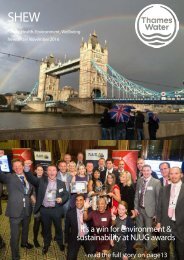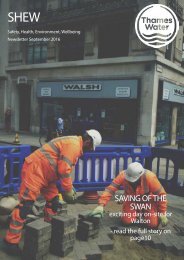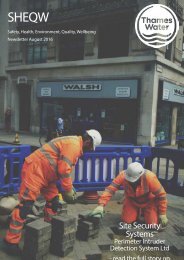March 2017
Create successful ePaper yourself
Turn your PDF publications into a flip-book with our unique Google optimized e-Paper software.
SHEW<br />
Safety, Health, Environment, Wellbeing<br />
Newsletter <strong>March</strong> <strong>2017</strong><br />
Discover the hoops<br />
eight 2<br />
O are jumping through to<br />
complete the HS2 enabling works<br />
- read the full story on page 8
Contents<br />
3. Welcome our new starters<br />
Get to know the latest members of the<br />
SHE team.<br />
4. Face Fit Testing<br />
5. In the Courts<br />
Looking at the latest environmental<br />
prosecution<br />
6. Spot the Environmental<br />
Hazard<br />
Spot the most hazards to win a prize!<br />
8. In the spotlight<br />
We look at the issues SMB have faced<br />
undertaking trial holes on the enabling<br />
works for HS2<br />
10. Steps for beating belly fat<br />
Focus on your health<br />
12. Reporting<br />
Latest SHE statistics<br />
13. SHE alerts<br />
Latest safety alerts for dissemination<br />
Welcome the latest members of<br />
the SHE team<br />
Paula Shaw<br />
My name is Paula Shaw, born in the U.K. and raised in the Netherlands. An<br />
Industrial & Organisational Psychologist by trade, I have worked in the Mining<br />
and Construction Industry for the past seven years of which 5.5 years in<br />
Western Australia and 1.5 years in Qatar. To complement my work experience I<br />
recently completed my diploma in Occ. Health and Safety.<br />
Beginning of January <strong>2017</strong> I joined the utilities team as a Health & Safety<br />
Advisor and will be based in the Thames Valley area. In my spare time I enjoy<br />
many active sports i.e. mountain biking and hiking.<br />
Barry Ryan<br />
I have a passion for implementing environmental and sustainability principals<br />
in construction. My academic background is Environmental Science and<br />
Environmental Engineering. I am a lead auditor on ISO14001 Environmental<br />
Management Systems.<br />
I have over six years experience within the water industry. I am very familiar<br />
with Thames Water have previously worked for J. Murphy and Sons on the<br />
AMP5 Optimise JV. My role involved implementing and maintaining the JV<br />
environmental management system and obtaining environmental permits and<br />
consents. Stakeholder engagement was a key component of my previous role<br />
and I have experience working with wildlife trusts, NGOs, Environment Agency<br />
and Natural England.<br />
In my spare time I enjoy watching most sports, particularly football, rugby and<br />
gaelic games.<br />
Sam Greensitt<br />
My name is Sam Greensitt, I play rugby, swim and have competed in a couple<br />
of triathlons, including the London triathlon a couple of years ago. I have an<br />
English bull terrier called George.<br />
I grew up in the west country before moving to Guildford in Surrey. I have<br />
worked in safety for a number of years and before joining eight 2<br />
O I worked<br />
for Clancy Docwra. I’m a firm believer that empowerment and a behavioural<br />
approach are key to creating a safe working culture.<br />
Page 2 | <strong>March</strong> <strong>2017</strong> SHEW Newsletter<br />
SHEW Newsletter<br />
<strong>March</strong>y <strong>2017</strong> | Page 3
Respiratory protective<br />
equipment at work<br />
Overview<br />
Some activities may result in harmful substances contaminating the air in the form of dust, mist, vapour, gas or<br />
fume. Activities such as the cutting of stone or wood, using a product containing volatile solvents or welding<br />
stainless steel require the use of respiratory protective equipment (RPE).<br />
As expected, there are many differing types of RPE, designed to protect the wearer from a known or expected<br />
hazard. RPE comes in different sizes to allow for facial differences, gender, ethnicity and build to be considered,<br />
since one size of face-piece will not fit everyone.<br />
Essentially RPE must be:<br />
• Adequate – It is right for the hazard and reduces exposure to the level required to protect the wearer’s<br />
health and;<br />
• Suitable – It is right for the wearer, task and environment, such that the wearer can work freely and without<br />
additional risks due to the RPE.<br />
Face Fit Testing<br />
Legislation stipulates that fit testing should be carried out as part of the initial mask selection process and a<br />
trained face fit tested must be used. The need for employees to have this will be assessed during the induction<br />
stage. Remember, under the law, RPE is the last line of protection.<br />
RPE will not protect the user if it leaks and the main cause of leaks is a poor fit. Wearers of RPE must be advised<br />
that to enable a clean seal between the mask and the face they must be clean shaven. If one of your operatives<br />
has facial hair then alternatives to tight fitting masks should be looked into (speak to your SHE Advisor for<br />
further guidance).<br />
Remember, a face fit test must be completed on an individual for all types of masks they use. The test need<br />
only be completed once every two years, but should be conducted again if the shape of the individuals faces<br />
changes significantly with all records being retained for at least 5 years.<br />
Face fit testing requirements must be stipulated in all RAM’s where applicable, with this requirement<br />
communicated to our sub-contractors. Lastly, you are required to conduct health surveillance when the risk<br />
assessment indicates that either a worker is exposed to dust linked to an occupational respiratory disease or<br />
adverse health effect or there is likelihood under work conditions that the disease might occur.<br />
In the court<br />
Council fined £73,000 for negligent waste management<br />
A Council and the company it used to transport waste have both been heavily fined for waste management<br />
offences. The fine was imposed when it was proven that they had breached their permit by storing wastes that<br />
were not included within the set conditions and exceeding the allowed volumes.<br />
Additionally, the waste transport company was prosecuted for keeping waste “in a manner likely to cause<br />
pollution,” and also for not describing their waste properly as per waste transfer note paperwork.<br />
This shows that we must ensure that our subcontractors as well as eight2O are managing their waste<br />
appropriately and ensuring that our waste carriers are complying with waste legislation.<br />
This can be done in various ways, including;<br />
• The Environmental Advisor will undertake waste audits on subcontractors, their facilities and carriers<br />
• Site teams must ensure subcontractors are fulfilling their duty of care, by checking Waste Transfer Notes<br />
(WTN’s), Carriers Registration, Permits & EA Verification checks.<br />
For more information on this, contact your Environmental Advisor.<br />
(The Environmentalist, January <strong>2017</strong>)<br />
Page 4 | <strong>March</strong> <strong>2017</strong> SHEW Newslet-<br />
SHEW Newsletter<br />
<strong>March</strong> <strong>2017</strong> | Page 5
Spot the Environmental<br />
Hazard<br />
Looking at the picture<br />
below, see if you<br />
can identify as many<br />
Environmental Hazards<br />
as possible.<br />
An Environmental Hazard is<br />
a substance, state or event<br />
which has the potential to<br />
threaten the surrounding<br />
natural environment and/<br />
or adversely affect people’s<br />
health.<br />
Send your answers to<br />
Lyndsey.curtis@skanska.<br />
co.uk before 31st <strong>March</strong><br />
and the winner will receive<br />
a prize!!! Good Luck!!!<br />
Page 6 | <strong>March</strong> <strong>2017</strong> SHEW Newsletter<br />
SHEW Newsletter<br />
<strong>March</strong> <strong>2017</strong> | Page 7
In the spotlight -<br />
HS2 Enabling Works<br />
1. Overview<br />
The new High Speed 2 (HS2) line and its associated stations are to be constructed within Thames Water Utilities<br />
Ltd’s Operational Area, resulting in the need for utility diversions. This includes a 42” Cast Iron clean water<br />
trunk main in Euston. The first phase of these works includes trial holes, window sampling, boreholes and CCTV<br />
surveying on a number of busy roads around Euston Station and also in Regent’s Park car park.<br />
4. Protecting local wildlife<br />
Trial hole work in Regent’s Park Car Park involved working closely with additional stakeholders, The Royal Parks<br />
(TRP) and Zoological Society of London (ZSL). A licence was issued by TRP and ZSL for these trial holes. Before<br />
this was issued there was considerable dialogue between HS2, Thames Water, TRP and ZSL to ensure that all<br />
environmental aspects were considered so that the work did not have a negative impact in the car park area<br />
and the hedgehogs living there.<br />
Regent’s Park is the only central London Park to contain breeding pairs of hedgehogs. Wildlife fencing ( below,<br />
left) has been installed to prevent hedgehogs from walking out onto the nearby busy road. Mass barrier<br />
fencing has also been erected around the site to prevent hedgehogs from entering the work area. This has<br />
been adapted to allow for a wildlife corridor around the site, only accessible by hedgehogs though! (below,<br />
right).<br />
2. Early Engagement with London Borough of Camden (LBoC)<br />
Early engagement has established a good relationship with the LBoC and has been vital especially when last<br />
minute changes have been required. Successes have included;<br />
• Prompt processing of many complex streetworks applications (Traffic Management and Parking Bay<br />
suspensions).<br />
• Granting of ten section 61 consents for the control of noise<br />
3. Challenges<br />
The site team has encountered, and overcome, a number of challenges at some of the work sites. The work<br />
is taking place along key traffic routes and close to many residential properties. These challenges have been<br />
mitigated by:<br />
• Directly engaging with stakeholders to clearly understand their concerns<br />
• Adapting work to minimise impact e.g. stopping work when sensitive activities were taking place at the<br />
nearby recording studio and churches; changing the programme to reduce the impact on the foot traffic to<br />
local schools; and working with businesses to agree re-directed routes for deliveries.<br />
ZSL provided hedgehog handling training to SMBJV’s ecologists so that any hedgehogs found near the works<br />
can be removed safely. Nesting boxes (below right) have also been placed within grassed areas of the car park<br />
to support the local population.<br />
Site team<br />
Project Manager: William Whitley<br />
Construction Manager: Monica Suchorska<br />
Construction Manager: Bernard Bosman<br />
Sub-contractor: Barhale<br />
H&S Advisor: Kieran Welsh<br />
Design Env. Advisor: Kathryn Hollard<br />
Construction Env. Advisor: Penny Roberts<br />
Ecologists: Gareth Lavery / David Macknay<br />
Page 8 | <strong>March</strong> <strong>2017</strong><br />
SHEW Newsletter SHEW Newsletter<br />
<strong>March</strong> <strong>2017</strong> | Page 9
Page 10 | <strong>March</strong> <strong>2017</strong> SHEW Newsletter SHEW Newsletter<br />
<strong>March</strong> <strong>2017</strong> | Page 11
Steps for beating belly fat<br />
The nicknames for the extra padding around your middle may be cute, but the reality of belly<br />
fat is anything but. Although fat can be found in almost any part of your body, the kind that<br />
attaches itself to your midsection tends to be the hardest to shed and the most resistant to<br />
spot exercises such as crunches.<br />
There are four keys to controlling belly fat:<br />
1. Exercise: Get at least 30 minutes of moderate exercise at least 5 days a week. Walking counts, as long as it’s<br />
brisk enough that you work up a sweat and breathe harder, with your heart rate faster than usual.<br />
2. Diet: There is no magic diet for belly fat. But when you lose weight on any diet, belly fat usually goes first.<br />
Getting enough fibre can help. That’s as simple as eating two small apples, a cup of green peas, or a halfcup<br />
of pinto beans.<br />
3. Sleep: Getting the right amount of shut-eye helps. In one study, people who got 6 to 7 hours of sleep per<br />
night gained less visceral fat over 5 years compared to those who slept 5 or fewer hours per night or 8<br />
or more hours per night. Sleep may not have been the only thing that mattered -- but it was part of the<br />
picture<br />
4. Stress management: Everyone has stress. How you handle it matters. The best things you can do include<br />
relaxing with friends and family, meditating, exercising to blow off steam, and getting counselling. That<br />
leaves you healthier and better prepared to make good choices for yourself.<br />
For more tips and advice on losing weight, you can download the January newsletter here.<br />
The Occupational Health and Welfare team are offering Waist Hip Ratio (WHR) measurements as part of the<br />
Personal Medical Assessments. This is a great indicator of your belly fat, and they can advise you on how to<br />
manage this.<br />
Page 12 | <strong>March</strong> <strong>2017</strong> SHEW Newsletter<br />
SHEW Newsletter<br />
<strong>March</strong> <strong>2017</strong> | Page 13
Nesting Birds<br />
Overview<br />
Nesting bird season runs from early <strong>March</strong> to the end of August, although seasonal weather<br />
changes can lengthen or shorten this.<br />
Birds usually nest in trees or hedges, but can also be found on the ground, in site equipment,<br />
among materials, in cabins, behind drains, down pipes etc.<br />
All birds are protected when nesting and it is illegal to kill, capture or disturb/damage birds, their<br />
nests or their eggs.<br />
Therefore, if a nesting bird is discovered, all works must be stopped until the nest is no longer in<br />
use.<br />
Unlimited fines are now being imposed and so the penalty for an offence (each bird may be<br />
deemed an offence) could be endless.<br />
A potential prison sentence of up to 6 months could also be incurred. Additionally, any vehicle<br />
involved may also be forfeited.<br />
Vegetation Clearance<br />
Where possible, avoid<br />
vegetation clearance during<br />
the nesting bird season.<br />
Vegetation checks during the<br />
breeding bird season and<br />
checks to see when birds have<br />
finished using their nests, must<br />
be carried out by an Ecologist<br />
or an Environmental Advisor.<br />
How can it affect your programme?<br />
NO MORE FAT FRIDAYS!!!!<br />
We need to ensure that we are planning our works around the nesting bird season, since<br />
excavating can only occur once any nesting birds have fledged.<br />
Failure to do so, can cause:<br />
Site teams at Swindon have decided enough is enough and have swapped bacon sarnie’s also known as ‘Fat<br />
Friday’ for sin free casseroles now known as ‘Fit Friday.’ This has promoted a healthier life style for all site teams,<br />
with some of them even joining the local slimming world group.<br />
Speak to your SHEW team if you want more information on how you can do this!!<br />
• Incurred costs<br />
• Programme delays (minimum of 4 weeks)<br />
• Breach of legislation and potential prosecution<br />
If you require any vegetation clearance, or think you may be working in a favourable location for<br />
nesting birds, then please contact your Environmental Advisor<br />
Page 14 | <strong>March</strong> <strong>2017</strong><br />
SHEW Newsletter<br />
SHEW Newsletter<br />
<strong>March</strong> <strong>2017</strong> | Page 15
SMB’s January’s reporting figures<br />
SHE Alerts<br />
98%<br />
47%<br />
LESSONS LEARNT<br />
LACERATION TO<br />
HAND<br />
100%<br />
Diversion of Excavated Material<br />
from landfill vs Target<br />
90%<br />
Recycled aggregate use<br />
It is the responsibility of the construction team<br />
to ensure that our subcontractors are using<br />
facilities which maximise recycling.<br />
LESSONS LEARNT -<br />
TRAPPED FINGERS<br />
STRUCTURES<br />
WITHOUT EDGE<br />
PROTECTION<br />
9<br />
8<br />
7<br />
6<br />
5<br />
OVERGROWN VERGE<br />
4<br />
3<br />
2<br />
1<br />
0<br />
Low Medium High Monthly Average<br />
Page 16 | <strong>March</strong> <strong>2017</strong><br />
SHEW Newsletter<br />
SHEW Newsletter<br />
<strong>March</strong> <strong>2017</strong> | Page 17
Passionate about everything we do
















